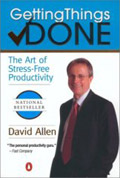
Ironically, looking in to the GTD (Getting Things Done) system has been bouncing around in the back of my head as something to do for quite some time now. This approach to maximizing productivity is popular among the nerdegalian, probably because of its minimum bullshit approach to actually processing, classifying, and executing what the author David Allen calls “stuff to do.” This book discusses the GTD system in its entirety and, more importantly, teaches you how to put it in place.
What I really liked about Allen’s work is that it’s very straight forward and focused on implementation. It seems like other self-help books in this vein that I’ve perused are all about inspiration, defining values, motivating yourself, getting in touch with your inner being and letting loose the full potential of you. To those authors I’d like to say the following: No. Stop it. I don’t need nor want that, so you can cram it with walnuts, buddy. GTD, in comparison, is prescriptive. Allen gets touchy-feeling in a few places (such as discussing prioritization or project definition) but the vast majority of the book takes a very practical approach to digging yourself out of whatever mountain of commitments you’ve gotten yourself under and how to stay on top of it once you get there.
In short, GTD focuses on getting “stuff” –commitments, to do items, reminders to gather information, requests for information or actions, etc.– out of your short-term memory and into a physical, highly organized system that will remind you of the right stuff at the right time. Dumping everything out of your short-term memory allows you to do something that’s very critical to productivity: focus on one thing at a time. If you’re confident that your other commitments or to-dos are safely stored away somewhere and will not be lost or buried out of sight, you can devote all your attention, time, and mental energy to one thing before knocking it out and moving on to the next. I like to think of the system as an artificial, external, and infinitely scalable attention span that you can connect to and disconnect from as needed.
That’s all well and good, but it’s probably not beyond the ken of your average retarded monkey. The tough (and in some places nonintuitive) part is the implementation. Again, there’s tons more detail, tricks, and tips in the book, but I’ll try to capture the gist of it. There are four major parts to the GTD system:
- Collecting incoming stuff
- Processing the stuff
- Doing the stuff
- Regularly reviewing your system to make sure your action items and project lists are up to date
Collecting stuff is easy. That’s just letting stuff accumulate in your physical or virtual receptacles like inboxes, voice mail, or e-mail.
Processing stuff is more involved. It requires sitting down with your inboxes and emptying them. That doesn’t mean immediately doing the work associated with each piece of stuff as you pick it up –prioritization is important. It means taking a piece of stuff –an e-mail, a document, a voice mail– and doing something with it: act on it right then, file it, trash it, delegate it, or create what Allen calls a “Next Action” item associated with it. Again, the book is replete with practical tips, hacks, tools, and rules of thumb for deciding which of these things to do and how to keep it all straight. Therein lies some of the book’s best value, but it’s too detailed to go into here.
Doing the stuff is self explanatory, but again I’ll emphasize the value of being able to focus on one thing at a time without worrying that other things will be forgotten. It’s much more productive and much less stressful.
Regularly reviewing your system is also important, and comes in two flavors: as needed and weekly. You may review your action item list (a.k.a., your “to do list”) several times a day as needed, if for nothing but that endorphin rush that comes with checking things off as “done” and deciding what to tackle next. Weekly reviews are also important, and are different in that you take the time to check on your list of active projects and make sure you have a Next Action item for each and every one.
So I really like the book and its system. I’d recommend it to anyone who feels like they’re not being productive enough or getting buried in work. Allen only gets mushy and non-specific in a few places that make it seem like he’s trying to pad the page count, but the majority of the book is specific, direct, and practical. I also like that Allen is in tune with the modern technology that most professionals encounter. He spends appropriate amounts of time discussing things like e-mail, Outlook and voice mail. He also talks about implementing GTD with high-tech tools like PDAs, Web 2.0 systems, and palmtop computers, but while GTD lends itself well to these kinds of toys, at its heart it is technology agnostic. You could do the whole thing quite effectively with a pen, some paper, and a bunch of file folders. Indeed, some parts of the system, like the tickler file work best that way.
Overall, I like it and have been following the system for a few weeks now. In the next few days or so I’ll follow up this post with another one about how I personally am implementing the GTD system at work. In the meantime, you can find out more about GTD at these places: Wikipedia’s entry on GTD, 43 Folders, and Black Belt Productivity. Or you could, you know, read the book.
Published by